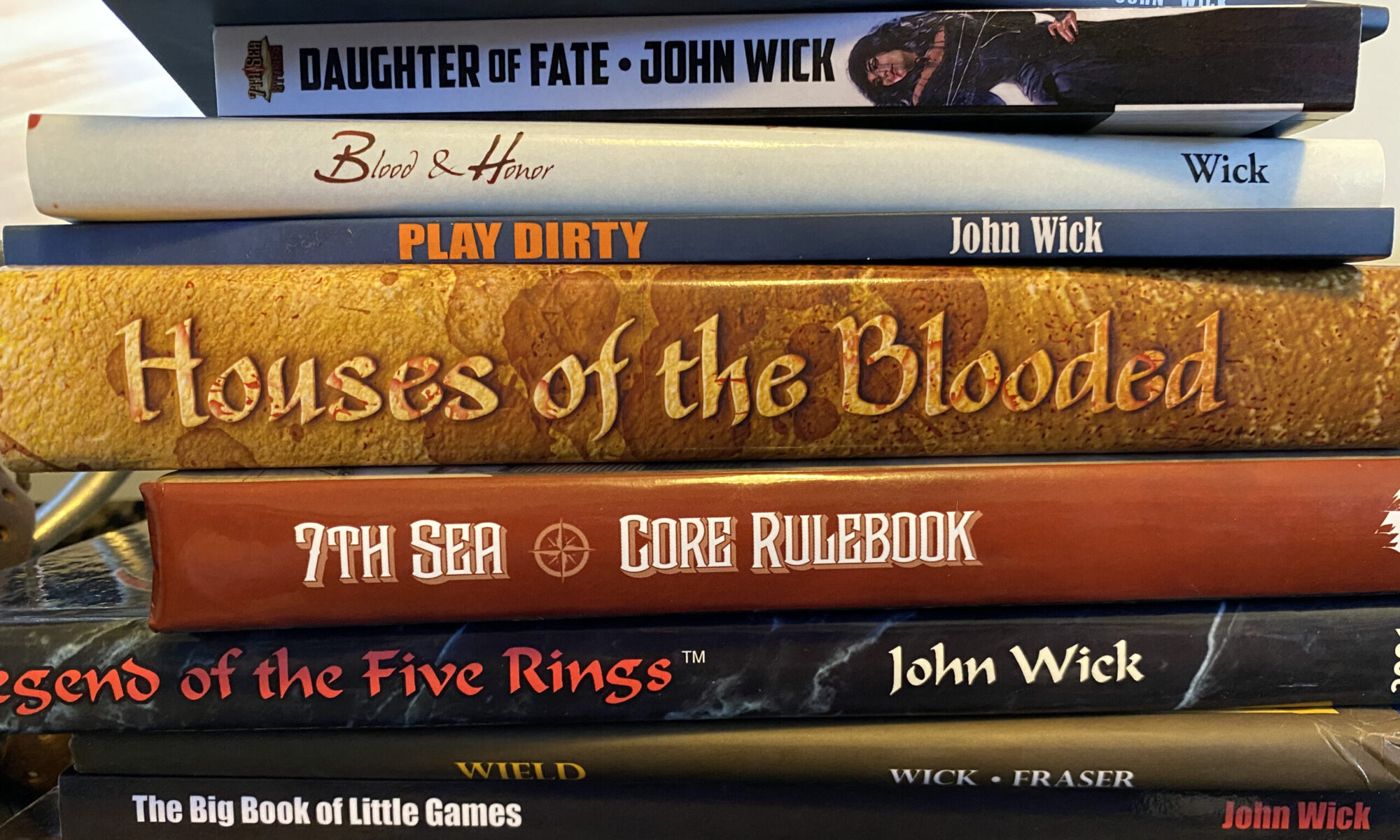In 1995, I joined AEG and started writing articles for Shadis magazine. A few months after joining, I was approached by David Williams, the CCG editor, about a card game tentatively called Bushido. It was supposed to be based on the Bushido RPG. AEG was negotiating buying the property. Just before I came aboard, that acquisition was in flux. Me joining up, knowing and understanding Japanese history and culture and suggesting we should develop our own property, pushed the rest of the office over the fence. We would do our own thing.
I spent the next four years designing and developing Legend of the Five Rings with some of the most talented people I’ve ever known. We were doing it ourselves, doing it for ourselves. We were the new kids, upstarts, all of us under 30, all of us working 80 hour weeks with no sleep, little food, and nothing to sustain us but our comraderie. We fought the industry, the distribution system, and ourselves. I still remember the post-Origins Award party when we won for Best Roleplaying Game and a person I admired and respected said, “Well, looks like a CCG finally won the best RPG award.”
I had little to do with the actual mechanical design of the CCG, but the RPG was my baby. I took advice from a lot of people, but I was a tyrant on that book. I was inspired by the James Bond RPG (as was Dave Williams) and we crafted something that some people are still calling one of the best RPG systems out there. We worked hard and we were rewarded with the appreciation of the greatest fans in the industry. No fans are as fun, loving, and devoted as L5R fans.
(I was sitting on the plane and a guy in a Phoenix Clan jersey was sitting on the other side of the aisle. The guy sitting next to me–who knew my history with the game–asked, “Are you going to say anything?” I didn’t. I didn’t know how to.)
After designing and developing 7th Sea with my then-wife, I spent another two years at AEG, working just as hard with people who didn’t quite understand the property. I think many of them thought, “European fantasy = D&D” and when they saw 7th Sea, they didn’t exactly know what to do with it. That’s my perception on it, anyway. I could be wrong.
Frustrations inside the company drove Jennifer to quit. I left a month later. Since then, I’ve worked in the video game industry, at Neopets, Upper Deck, and even spent a long time working with orphans. Rewarding work that made me forget about the petty bullshit that went on in my gaming past. But a leopard can’t change his spots. Game design is what I do. I think it is what I do best.
(That and something else that is too sensitive to talk about in front of such refined company.)
Then, in 2001, I met Jared Sorensen. I met him at Kubla-Con (The King of Cons!) on a panel talking about game design. We talked, laughed, and went our seperate ways. It wasn’t until months later that Jennifer and I bumped into him at a food court in Marin County. We exchanged phone numbers and started hanging out on a regular basis. He showed me octaNe and my whole view of roleplaying games changed.
Back in 2001, Jared was doing what everybody else is doing now. Fucking with narrative control, fucking with the notion of “who is the GM?”, fucking with every assumption I had about RPGs. Hell, fucking with every single assumption everyone had about roleplaying games. He was young, brilliant, and looked exactly like Percival.
I was infected with the God. Enthused.
For the next four years (five, really), I spent time in the trenches of “the indie movement,” a torrent of ideas, disagreements and delusions. In that place, there were people who agreed with me on many design philosophies, but at the same time, disagreed with others. I looked at myself, redefined who I was–who “John Wick” was–and crashed head first into all those assumptions Jared had been dancing around.
I designed Enemy Gods, Cat, Thirty and Discordia with Jared’s inspiration, and with the encouragement of others. Ron Edwards, Clinton Nixon, Thrymm… they all pushed my head under the water and wouldn’t let me come back up until I had a different answer. I saw other designers like Luke Crane doing design his own mad way. I admired them, considered them allies.
This Gen Con, there was something in the air. I do not believe in destiny, fate, or kharma, but something was about to happen. This Gen Con, something did happen. Two things, actually. Neither of these things I can talk about just yet, but they both forced me to re-evaluate my path. Seeing Burning Empires did something to me. It reminded me of something. A feeling I had a long time ago when I first held the L5R RPG in my hands. Luke did something amazing with that book. He…
… I remember an angry voice. Someone shouting. Someone saying something about “raising the bar…”
Luke did it. Go out and compare Burning Empires with D&D 3.0. I dare you. I double dare you. But only do it if you are willing to be afraid.
Luke hit me with that book, harder than Monte could ever hit me with his. (And I deserve a swat for what I said about Monte’s book.) And he made me realize something.
Not yet. Almost, but not yet. Still more cryptic mentions, still more hints. More to come. But until then, go check out Burning Empires.
It’s Big.
Like the games I used to do.
The games people keep asking me to do.
